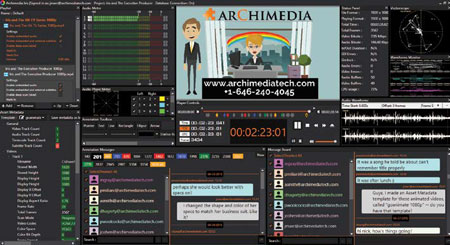IMF Comes to the Rescue
As the new year dawns, if the purpose of an editor is to take raw chaos (source material) in the left hand and produce creatively crafted meaning (finished masters) out of the right, we are in for a major paradigm change. And its name is Interoperable Master Format or “IMF.”

Some mega hit films such as Disney’s “Frozen” need to be released in as many as 35,000 different deliverable formats. The impetus behind the IMF initiative is the massive data requirements needed to produce all the different formats the international and multiplatform marketplace demands for a major broadcast or theatrical release.
Several people have told me a film such as Walt Disney Studios’ mega hit “Frozen” needs to be released in as many as 35,000 different deliverable formats, so the days when an editor could simply swap out a language track to create a foreign version are long gone. That is one reason Netflix, a pioneer in 4K distribution to the home, requires all UHD or 4K productions be submitted to them as IMF files.
ESSENTIALS ONLY
Stripped down to its essentials, an XML-based IMF file contains all of the elements that comprise a given project including source video, production audio, subtitles, vfx and anything else that will appear on the screen along with all of their associated metadata. Then a Composition Playlist (CPL) tells the system how to put it all together, and an Output Profile List (OPL) specifies how it is to be played out.
Arjun Ramamurthy, vice president of technology at 20th Century Fox, was involved with the development of IMF from the beginning in 2009 when the Hollywood studios asked the Entertainment Technology Center (ETC) at the University of Southern California to create a standardized set of requirements for advanced mastering.
“The preliminary specification was handed off to SMPTE in 2011, and they then broke the project into ad hoc groups to finish the work,” said Ramamurthy. “Fundamentally, it makes a lot of sense for content owners. The biggest questions are, ‘where do we introduce it into the production flow?’ and ‘how do we create a standard that the industry will universally accept?’ After all, duplicating masters for each different version may be cumbersome, but it is a train on the track that is working and it can sometimes be hard to make an aircraft carrier turn around quickly.”
Within SMPTE, Pierre-Anthony Lemieux chairs technology committee 31FS, which is directly related to IMF, and where he is responsible for editing the IMF standard, (he also serves as a partner at Sandflow Consulting).
“The initial version was standardized in 2013, and anyone can download them from the SMPTE site,” Lemieux said. “The first revision or IMF 1.1, the last step before publication, should be ready early this year. It includes support for high dynamic range, higher frame rates (120 fps), wider color gamut and international subtitles.”

In December, Archimedia Technologies released a major upgrade to it Iris software suite that lets users collectively view IMF projects through the cloud from a Windows or Mac platform totally through software. Although when the drive for IMF started, there were only six production entities in the United States that were distributing internationally, Lemieux said the success of digital cinema has accelerated the need for its worldwide acceptance.
“What was originally intended for internal studio operation has now become a format of interest to multiple entities,” he said. “IMF is the only format that fits the need for truly international distribution. There are other attempts, such as AS-O2, but it has not kept up to date with the times and lacks, for example, high dynamic range. IMF is a close cousin to digital cinema, and benefits from all the development that has gone into specifying DCI [Digital Cinema Initiative] files.”
Sony has been involved with IMF since its inception at ETC. Bill Baggelaar, senior vice president of technology, production and post production technologies, Sony Pictures Entertainment, said that in the linear tape era there was no truly open videotape format.
“All the tape formats were proprietary,” he said, “so when we conceived of IMF we wanted a long-term view that meant its open format would still be relevant many years in the future. Its genesis lies in the conventional Edit Decision List [EDL], but that was only concerned with the source side. The real value of IMF is all the metadata it brings with it to create the output of the production.”
IMF MASTERING
Wanting to have as many of their home theater releases available in UHD as soon as possible in anticipation of eventual market demand, Baggelaar said Sony worked closely with Rohde & Schwarz, (previously DVS), whose Clipster mastering system has been at the forefront of creating IMF files for major Hollywood productions.
Introduced in 2003, Clipster became renowned for producing digital intermediates, and as Stephen Birdsong, product manager, post production solutions at Rohde & Schwarz DVS, said, this has evolved into IMF mastering. At the 2015 IBC Show, the company launched Clipster generation 6, a new hardware platform including a JPEG2000 video accelerator, according to Birdsong. “Most importantly, it can transform any color format into an IMF with Rec. 2020 color space specifications, far more than HD’s Rec. 709, along with HDR, and high frame rate,” he said.
But to make collaborative viewing of IMF files feasible from the four corners of the world, a shared viewing system is greatly needed. Fortunately, last month, Archimedia Technologies released a major upgrade to it Iris software suite that lets you collectively view IMF projects through the cloud from a Windows or Mac platform totally through software.
“This upgrade to Iris makes it the world’s first software media player for IMF complex files,” said Mark Gray, CEO of Archimedia Technology. “This includes file consistency through template matching, live caption extraction and display, and automated sidecar information transfer that can include program guides or external information related to the media file.”
Having the ability to play all of that in real time through a desktop software application, and keep it all absolutely frame accurate no matter in what part of the globe it is being viewed, will expand the viability of IMF as both a distribution and review format.
“Our Iris Desktop software suite comes in two flavors,” Gray said. “One is an Iris Reference Appliance that is available with its own hardware that is intended for hightech quality control suites. The other is called Iris Pro for the non-technical user with all of the viewing and annotating capabilities of its larger brother.”
Considering that a full 4K digital master for a complex feature release can easily take to 15 TB of data, we can all hope for the rapid standardization and universal adoption of IMF mastering files.
Jay Ankeney is a freelance editor and post-production consultant based in Los Angeles. Write him atJayAnkeney@mac.com.
Get the TV Tech Newsletter
The professional video industry's #1 source for news, trends and product and tech information. Sign up below.
